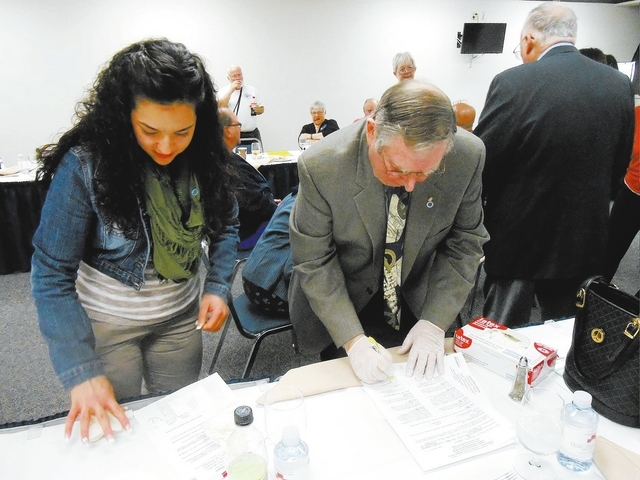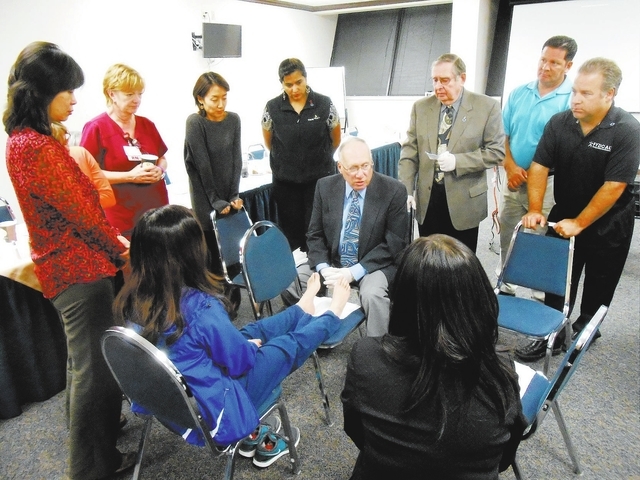Summerlin Lions partner with medical community to test for diabetic foot problems
All it takes is a poke.
A simple test that involves poking the feet of people with diabetes in predetermined, nerve-sensitive areas of the foot can help avoid future problems, including amputation. The painless test is done with a special nylon filament that resembles a short piece of fishing line.
The layperson might call it “Poke a Foot, Save a Leg.”
People with diabetes who cannot feel the filament are likely to have diabetic peripheral neuropathy, a complication of diabetes in which nerves in the legs and feet are damaged. This nerve damage is the major cause of amputations in people with diabetes.
The Summerlin Lions Club has taken diabetes to heart and offers classes for various levels of the medical community on how to detect foot problems. At the forefront of the effort is Lawrence Rubin, a retired podiatrist who was instrumental in establishing the nonprofit Lower Extremity Amputation Prevention Alliance.
“I take pride in being a member of the Summerlin Lions Club. We are first club in the world to offer this amputation-prevention service to our community,” Rubin said.
The LEAP Alliance was formed to recruit podiatrists and other health professional volunteers to train Lions Club members to go to health fairs and wellness events to test for nerve damage with the filament. Another retired podiatrist, Leonard Franklin, teamed with Rubin to do the training.
LEAP has fostered a new alliance between the Summerlin Lions Club’s medical members and Desert Springs Hospital Medical Center, 2075 E. Flamingo Road. On Nov. 14, World Diabetes Day, the LEAP Alliance and the Summerlin Lions Club hosted an evening training session at the hospital.
Rita Schmidt, a registered nurse, said people in her profession don’t know about the test because “regular (general practitioners) normally don’t do this. This (training) is great because we are the Diabetes Treatment Center at Desert Springs, so we see diabetics every day.”
An annual comprehensive diabetic foot examination can prevent up to 80 percent of diabetic lower extremity complications and amputations, according to the American Podiatric Medical Association.
Its other statistics on diabetes are sobering. Diabetes affects 25.6 million Americans, and up to 25 percent of them will develop a foot ulcer. More than half of all such ulcers will become infected and require hospitalization.
Every 24 hours, there are 230 foot amputations in the United States, and 50 percent of those who have an amputation will have a second one within two years.
To combat those statistics, LEAP is reaching out to the medical community on the front lines — such as visiting nurses, physical therapists, and even massage therapists — so they know how to conduct the test.
Brian Werner, a physical therapist and president of Fyzical Therapy and Balance Center, 9080 W. Cheyenne Ave., Suite 150, was there. Werner joined the Summerlin Lions Club’s medical team because he heard of its diabetes foot-screening program.
“I specialize in working with fall-risk seniors and patients with neuropathy,” he said. “So, we see a lot of peripheral neuropathy cases, and my specialty is amputees. I see a lot of folks who, if we had picked up on the diabetic neuropathy early on, (they) could have avoided coming to see me to get trained for walking with a prosthetic limb.”
The tester has the person with diabetes close his eyes or cover his face so he cannot see the test being performed. A filament about 3 inches long is pressed against the foot at about a dozen strategic nerve-sensitive points.
The tester presses only hard enough to bend the thin nylon line. The filament that’s used can be compared to an 8-pound fishing line.
The person with diabetes alerts the tester whenever he can feel the poke.
The hands-on training had the attendees taking turns between being the tester and the one being tested.
The instruction also showed how to do a more thorough assessment, such as a visual inspection for the onset of bunions and hammer toes, both of which can be precursors for foot ulcers. Checking for vascular health meant pressing down on the top of the big toe, or its nail, until it turned white. After letting up the pressure, it should return to a normal color within three seconds, attendees were told.
By the end of the night, 15 health professionals had been certified.
“By getting Lions members out into the public (to test them) in order to save limbs, it’s a win-win for everyone,” Rubin said. “Most certainly, the diabetic who would have lost his or her leg if not for us finding the problem, that diabetic wins. The Summerlin Lions Club wins because Lions are dedicated to helping combat diabetes complications. There are 1.3 million Lions in this world, and each and every one of them has a dedication to doing something valuable in the area of diabetes.”
For more information, visit leapalliance.org or call Rubin at 702-233-5253.
Contact Summerlin/Summerlin South View reporter Jan Hogan at jhogan@viewnews.com or 702-387-2949.
Lower Extremity Amputation Prevention Alliance
For more information, visit www.leapalliance.org or call Lawrence Rubin at 702-233-5253.


















